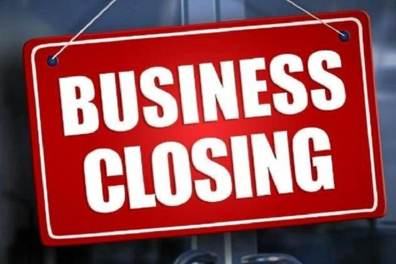
Closing Down a Business: Which Option Should You Choose
[fusion_builder_container hundred_percent=”no” hundred_percent_height=”no” hundred_percent_height_scroll=”no” hundred_percent_height_center_content=”yes” equal_height_columns=”no” menu_anchor=”” hide_on_mobile=”small-visibility,medium-visibility,large-visibility” status=”published” publish_date=”” class=”” id=”” background_color=”” background_image=”” background_position=”center center” background_repeat=”no-repeat” fade=”no” background_parallax=”none” enable_mobile=”no” parallax_speed=”0.3″ video_mp4=”” video_webm=”” video_ogv=”” video_url=”” video_aspect_ratio=”16:9″ video_loop=”yes” video_mute=”yes” video_preview_image=”” border_size=”” border_color=”” border_style=”solid” margin_top=”” margin_bottom=”” padding_top=”” padding_right=”” padding_bottom=”” padding_left=””][fusion_builder_row][fusion_builder_column type=”1_1″ layout=”1_1″ spacing=”” center_content=”no” link=”” target=”_self” min_height=”” hide_on_mobile=”small-visibility,medium-visibility,large-visibility” class=”” id=”” background_color=”” background_image=”” background_image_id=”” background_position=”left top” background_repeat=”no-repeat” hover_type=”none” border_size=”0″ border_color=”” border_style=”solid” border_position=”all” border_radius=”” box_shadow=”no” dimension_box_shadow=”” box_shadow_blur=”0″ box_shadow_spread=”0″ box_shadow_color=”” box_shadow_style=”” padding_top=”” padding_right=”” padding_bottom=”” padding_left=”” margin_top=”” margin_bottom=”” animation_type=”” animation_direction=”left” animation_speed=”0.3″ animation_offset=”” last=”no”][fusion_text columns=”” column_min_width=”” column_spacing=”” rule_style=”default” rule_size=”” rule_color=”” hide_on_mobile=”small-visibility,medium-visibility,large-visibility” class=”” id=””]
When a solvent company ceases to trade actively, its director confronts the big question of what to do with the company structure. Should it stay dormant? Or should it be deregistered, or be wound up via a members’ voluntary liquidation? Read on to find out which option is best for you.
Keep a Company Dormant
Letting a company stay dormant allows it to remain registered with the ASIC, and to return to active operation immediately if and when the need arises.
However, a dormant company will still need to comply with statutory obligations, such as to pay the ASIC an annual review fee and attend to tax commitments. Moreover, it has the same legal status as an active company, hence there is no impediment to institute legal proceedings against it. Therefore, the benefits of keeping a dormant company have to be weighed against compliance burdens and the risk of potential legal claims.
Usually, unless it is anticipated to have a new purpose in the foreseeable future, keeping a company dormant is rarely the best way forward.
Deregister a Company
The effect of deregistration is rather self-explanatory: the company is dissolved, cease to be a legal entity and deregistered with the ASIC. Deregistration can occur in the following two ways:
- ASIC-initiated deregistration occurs when the ASIC automatically strikes off a company for failure to comply with its aforementioned statutory obligations for an extended period.[i]
- A company is eligible to voluntarily deregister if it satisfies the following conditions:
- all members of the company agree to deregister;
- the company is not conducting business;
- the company’s assets are worth less than $1000;
- all fees and penalties payable under the Corporations Act (i.e. to ASIC) are paid;
- the company has no outstanding liabilities (e.g. debts or unpaid employee entitlements);
- the company is not involved in any legal proceedings.[ii]
Upon successful application the company would be deregistered with the ASIC in 2 months. Once a company is deregistered, it is relieved from its statutory obligations, and the personal risk of liability of its officers is significantly reduced because the company cannot be directly litigated against.
The primary advantage of a voluntary deregistration is its speed and low cost. As a voluntary deregistration does not involve the appointment of a liquidator and costs a mere $41 for application, it is probably the cheapest and quickest way to officially close down a company. However, voluntary deregistration does not conclusively absolve directors from past liabilities. A person who is legally aggrieved (e.g. unpaid creditor) by the company’s deregistration may apply for a court order to reinstate the company.[iii] If the court is satisfied that it is just to do so, the company would be reinstated and can then be claimed against: past cases have demonstrated the courts’ willingness to reinstate companies so that the Australian Taxation Office can pursue outstanding tax liabilities.[iv]
Members’ Voluntary Liquidation
A members’ voluntary liquidation is initiated by a majority of company directors resolving to make a declaration of solvency, which proclaims that the company is able to fully pay back its creditors within 12 months.[v] This declaration is lodged with the ASIC and a members’ meeting is convened. If the special resolution to wind up the company is approved by the shareholders, a liquidator would be appointed to wind up the company according to established rules and procedures.
Members’ voluntary winding up is the only way to fully wind up the affairs of a solvent company. The liquidator is an independent professional in charge of the process, obligated to ensure all tax, legal and accounting procedures are properly performed, that company assets are realised and liabilities appropriately settled. Thus, the greatest benefit of a members’ voluntary liquidation is finality, in that all parties involved can move on to the next chapter assured in the knowledge that unpleasant surprises concerning the company would not appear after liquidation.
Key Takeaways
- Keeping a dormant company is only suitable when the company is anticipated to have a new purpose in the foreseeable future.
- Voluntary deregistration is only suitable when the company’s affairs have been totally and appropriately finalised; otherwise ghosts from past may reappear to haunt the company.
- In all other circumstances, go for members’ voluntary liquidation for peace of mind.
The team at Collins Wentworth are experienced in business financial matters. If you have concerns about the financial position of your business and wish to know more about how we can assist you, contact us today.
[i]. ASIC-initiated deregistration of company, Australian Securities & Investments Commission; https://asic.gov.au/for-business/closing-your-company/deregistration/#ASICDereg
[ii]. Voluntarily deregistering a company, Australian Securities & Investments Commission; accessible from https://asic.gov.au/for-business/closing-your-company/deregistration/voluntarily-deregistering-a-company/
[iii]. Section 601AH(2), Corporations Act 2001 (Commonwealth); accessible from http://www5.austlii.edu.au/au/legis/cth/consol_act/ca2001172/s601ah.html
[iv]. See for instance, Anttila Enterprises Pty Ltd [2011] FCA 203, Binetter [2011] FCA 184, and Civic Finance Pty Ltd [2010] FCA 1411.
[v]. Winding up a solvent company, Australian Securities & Investments Commission; accessible from https://asic.gov.au/for-business/closing-your-company/deregistration/winding-up-a-solvent-company/
[/fusion_text][/fusion_builder_column][/fusion_builder_row][/fusion_builder_container]











